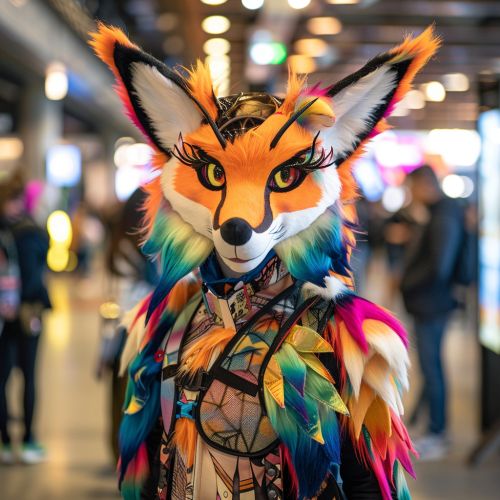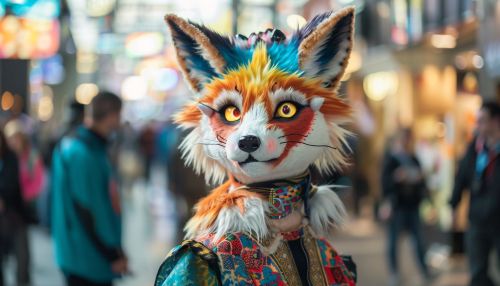Fursuits: Difference between revisions
(Created page with "== Introduction == A fursuit is a costume that represents an anthropomorphic animal character, often associated with the furry fandom. These costumes are typically worn for personal enjoyment, public events, conventions, and performances. Fursuits can range from simple designs to highly intricate and detailed creations, incorporating various materials and technologies to enhance the realism and functionality of the costume. == History == The origins of fursuits ca...") |
No edit summary |
||
| Line 59: | Line 59: | ||
* [[Midwest FurFest]] | * [[Midwest FurFest]] | ||
[[Image:Detail-92257.jpg|thumb|center|A person wearing a colorful, detailed fursuit of an anthropomorphic fox character, standing in a convention hall.|class=only_on_mobile]] | |||
[[Image:Detail-92258.jpg|thumb|center|A person wearing a colorful, detailed fursuit of an anthropomorphic fox character, standing in a convention hall.|class=only_on_desktop]] | |||
== Categories == | == Categories == | ||
Latest revision as of 11:41, 17 June 2024
Introduction
A fursuit is a costume that represents an anthropomorphic animal character, often associated with the furry fandom. These costumes are typically worn for personal enjoyment, public events, conventions, and performances. Fursuits can range from simple designs to highly intricate and detailed creations, incorporating various materials and technologies to enhance the realism and functionality of the costume.
History
The origins of fursuits can be traced back to the early 20th century, with the development of mascot costumes for sports teams and entertainment purposes. However, the modern concept of fursuits as part of the furry fandom began to take shape in the 1980s and 1990s. Early fursuits were often homemade and rudimentary, but as the furry community grew, so did the demand for more sophisticated and professionally crafted costumes.
Construction
Fursuit construction is a complex and multifaceted process that involves several specialized techniques and materials. The primary components of a fursuit include the head, body, hands, feet, and tail. Each of these components requires careful planning and execution to achieve the desired look and functionality.
Materials
Fursuits are typically made from synthetic fur, foam, and various fabrics. The choice of materials depends on the desired appearance, durability, and comfort of the costume. Synthetic fur is available in a wide range of colors, textures, and lengths, allowing for a high degree of customization. Foam is commonly used to create the underlying structure of the head and other padded areas, providing shape and support.
Techniques
Several techniques are employed in the construction of fursuits, including sewing, sculpting, and airbrushing. Sewing is used to assemble the various fabric components, while sculpting techniques are applied to shape the foam and other structural elements. Airbrushing is often used to add detailed coloration and shading to the fur, enhancing the overall realism of the costume.
Electronics and Animatronics
Advanced fursuits may incorporate electronics and animatronics to enhance their functionality and interactivity. Common features include LED lights, fans for ventilation, and moving parts such as eyes, ears, and mouths. These elements require careful integration and control to ensure they operate smoothly and safely.
Types of Fursuits
Fursuits can be categorized into several types based on their design and intended use. The most common types include partial suits, full suits, and quad suits.
Partial Suits
Partial suits consist of a head, hands, feet, and tail, but do not include a full body covering. These suits are often worn with regular clothing and are popular for their ease of use and comfort.
Full Suits
Full suits cover the entire body and provide a more immersive and complete representation of the character. These suits can be more challenging to wear due to their weight and heat retention, but they offer a higher level of visual impact.
Quad Suits
Quad suits are designed to mimic the appearance and movement of a four-legged animal. These suits require the wearer to walk on all fours, often using specialized stilts or extensions to achieve the correct posture. Quad suits are among the most complex and physically demanding types of fursuits.
Cultural Significance
Fursuits hold significant cultural value within the furry fandom. They serve as a means of self-expression and creativity, allowing individuals to embody their chosen characters and engage with the community in a unique and personal way. Fursuits are often showcased at conventions, parades, and other public events, where they contribute to the vibrant and diverse culture of the furry fandom.
Health and Safety
Wearing a fursuit can pose several health and safety challenges, primarily related to heat stress and restricted vision. Fursuits are typically insulated and can become very hot, especially during physical activity. To mitigate these risks, fursuiters often use cooling vests, fans, and take frequent breaks to stay hydrated and cool.
Restricted vision is another concern, as the design of fursuit heads can limit the wearer's field of view. This can increase the risk of accidents and collisions, particularly in crowded or unfamiliar environments. Fursuiters are advised to have a handler or assistant to help navigate and ensure their safety.
Community and Events
The furry community is known for its strong sense of camaraderie and support, and fursuiting is a central aspect of many community events. Furry conventions, such as Anthrocon and Midwest FurFest, provide opportunities for fursuiters to showcase their costumes, participate in parades, and engage in various activities and workshops.
See Also


